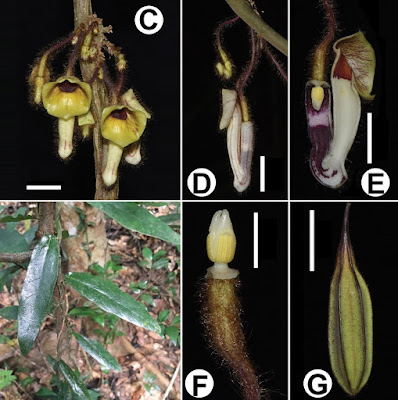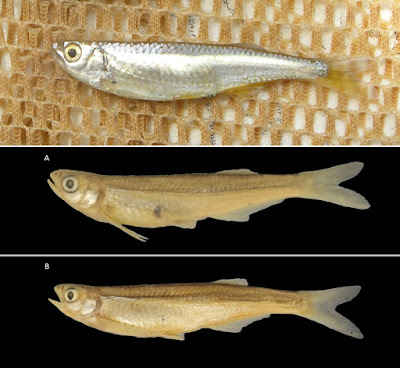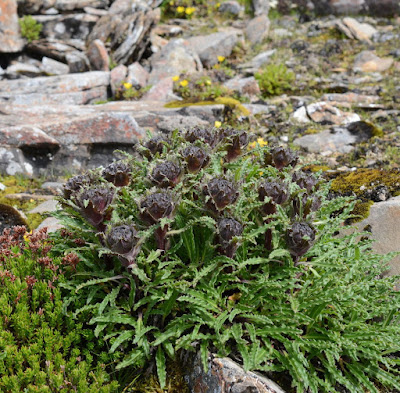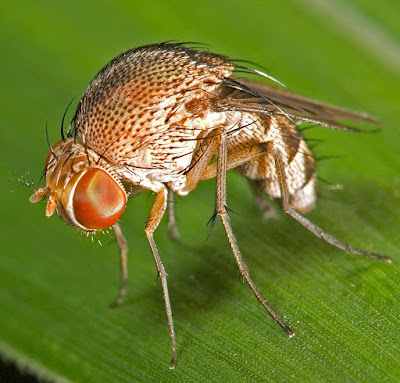[Most Recent Entries] [Calendar View]
Tuesday, August 13th, 2019
| Time | Event | ||||||||
| 4:11a | [Botany • 2019] Isotrema sanyaense • A New Species of Aristolochiaceae from Hainan, China
Abstract Isotrema sanyaense R.T.Li, X.X.Zhu & Z.W.Wang, sp. nov., a new species from Hainan island, China, is described and illustrated here. It is morphologically most similar to I. ledongense (Han Xu, Y.D.Li & H.J.Yang) X.X.Zhu, S.Liao & J.S.Ma and I. jianfenglingense (Han Xu, Y.D.Li & H.Q.Chen) X.X.Zhu, S.Liao & J.S.Ma in the shape of leaf, flower, and the yellow to brown villous indumentum of the pedicel, ovary and calyx. However, I. sanyaense can be easily distinguished from the latter two species by its 1–5-flowered cymes, in hanging clusters of 1 to numerous branches, upper calyx tube obviously longer than basal calyx tube, calyx limb discoid, yellow inside, with purple-red stripes and spots, about 13–18 mm in diameter, glabrous, and a throat dark red without spots, 4–6 mm wide. Keywords: Aristolochia, Aristolochia subgenus Siphisia, Asia, morphology, taxonomy Isotrema sanyaense R.T.Li, X.X.Zhu & Z.W.Wang, sp. nov. Diagnosis: Isotrema sanyaense is most similar to I. ledongense (Han Xu, Y.D.Li & H.J.Yang) X.X.Zhu, S.Liao & J.S.Ma and I. jianfenglingense (Han Xu, Y.D.Li & H.Q.Chen) X.X.Zhu, S.Liao & J.S.Ma (Zhu et al. 2019), but significantly differs in the following characters: cymes 1–5-flowered, in hanging clusters of 1 to numerous branches, the pedicel nearly equal in length to flower, upper calyx tube obviously longer than basal calyx tube, calyx limb discoid, yellow inside, with purple-red stripes and spots, about 13–18 mm in diameter, glabrous, the throat dark red without spots, 4–6 mm wide. A detailed morphological comparison among the three species is shown in Figure 4 and Table 1. .... Etymology: The specific epithet is derived from the type locality, Sanya City, in Hainan island, China. The Chinese name is given as “三亚关木通”. Distribution and habitat: Isotrema sanyaense is currently known from Haitangwan Town, Haitang District, Sanya City, Hainan Province, China. It grows in lowland dry forests dominated by families including Euphorbiaceae, Fagaceae, Lauraceae, Myrtaceae, Arecaceae and Rubiaceae at elevations between 332–400 m. Rongtao Li, Zhiwei Wang, Jun Wang, Xinxin Zhu and Han Xu. 2019. Isotrema sanyaense, A New Species of Aristolochiaceae from Hainan, China. PhytoKeys. 128: 85-96. DOI: 10.3897/phytokeys.128.35042 | ||||||||
| 2:25p | [Ichthyology • 2019] Neobola kinondo • A New Species of Cyprinoid Fish (Actinopterygii: Danionidae) from the Tana River, Kenya
Abstract Sampling of streams in the middle reaches of the Tana River Basin in Meru National Park, Kenya, from 2010 to 2012 for an NSF-funded International Research Experiences for Students (IRES) project, resulted in the capture of a number of specimens of what were first thought to be Neobola fluviatilis. On closer examination the specimens were determined to represent a distinct species, endemic to the Tana River basin, which is herein formally described. The new species is readily diagnosed from N. fluviatilis by higher counts of lateral line, pre-dorsal, and caudal peduncle circumferential scales, higher numbers of pectoral rays, lower numbers of anal fin rays, and a shorter anal-fin base length. Keywords: Actinopterygii, Neobola fluviatilis (Whitehead 1962), Neobola kinondo sp. nov., Cyprinoidei, East Africa
Neobola kinondo sp. nov. Engraulicypris fluviatilis (in part), Whitehead 1962:100 (Distribution, Tana River). Engraulicypris fluviatilis (in part), Howes, 1984:156 (Distribution, Tana River). Engraulicypris fluviatilis (in part), Lévêque & Daget 1984:326 (Distribution, Tana River) Engraulicypris fluviatilis (in part), Seegers et al. 2003:34 (Distribution, Tana River) Diagnosis Neobola kinondo is readily diagnosed from its presumed closest relative, N. fluviatilis, by higher counts of lateral line scales (mode 41, range 38–47, x̄ = 41.83 vs. mode 40, range 37–41, x̄ = 38.22 in N. fluviatilis, Table 2), predorsal scales (mode 24, range 20–27, of 23.90 vs. mode 19-20, range 17–22, x̄ = 19.38 in N. fluviatilis, Table 3), and caudal peduncle circumferential scales (mode 14, range 12–16, x̄ = 13.90 vs. mode 13, range 10–13, x̄ = 12.57 in N. fluviatilis, Table 4), and lower counts of transverse scales (mode 9, range 7–11, x̄ = 9 vs. mode 10, range 8–10, x̄ = 9.64 in N. fluviatilis, Table 5), principal dorsal-fin rays (mode 8, range 7–9, x̄ = 7.93 vs. mode 9, range 8–9, x̄ = 8.63 in N. fluviatilis, Table 6) and principal anal-fin rays (mode 18, range 18–23, x̄ = 19.23 vs. mode 22, range 20–24, x̄ = 22.17 in N. fluviatilis, Table 7). Combining lateral line scales and pre-dorsal scales completely separates N. kinondo from N. fluviatilis. Neobola kinondo has a combined count of 61 or more scales; N. fluviatilis has fewer than 61 lateral line and predorsal scales (Fig. 3). Neobola kinondo differs from N. bottegi by its higher numbers of lateral line scales (38–45 vs. 37-40 in N. bottegi) and principal anal fin rays (18-23 in N. kinondo vs. 14–18 in N. bottegi), and a more triangular pectoral axial scale (vs. more lanceolate in N. bottegi). Neobola kinondo differs from N. moeruensis by its higher numbers of principal anal fin rays (18–23 vs. 14 in N. moeruensis) and higher caudal peduncle circumferential scales (mode 14 in N. kinondo vs. 12 in N. moeruensis. Neobola kinondo differs from N. nilotica by its lower modal numbers of lateral line scales and principal anal fin rays (41 and 18, respectively, vs. 44 and 22, respectively in N. nilotica). Neobola kinondo is readily distinguished from N. stellae by its lower count of gill rakers on the first ceratobranchial (7 vs. 10 in N. stellae).
Etymology: The specific epithet of the new species “kinondo” is the Ameru language word for “silver” and is in reference to the bright silver color of the sides of N. kinondo. Species of Neobola are commonly referred to as sardines because of their sardine-like appearance. Thus, we suggest the common name, Tana Sardine. Distribution: Neobola kinondo is confined to the Tana River of Kenya (Fig. 6). It is known primarily from tributaries of the Tana in Meru National Park and likely also occurs in portions of the Tana River proper bordering the park. The only other record of the species is based on a single juvenile specimen collected from a locality on the lower Tana River near the Hola Concentration Camps, Tana River County (BMNH 1966.8.25.6), suggesting that the species also inhabits lower portions of the Tana River Basin. Henry L. Bart Jr, Ray C. Schmidt, Wanja Dorothy Nyingi and Joseph Gathua. 2019. A New Species of Cyprinoid Fish from the Tana River, Kenya (Actinopterygii: Danionidae). Zootaxa. 4652(3); 533–543. DOI: 10.11646/zootaxa.4652.3.9 | ||||||||
| 2:48p | [Botany • 2019] Saussurea balangshanensis (Asteraceae) • A New Species from the Hengduan Mountains region, SW China
Abstract Saussurea balangshanensis, based on populations from Balang Mountain in the Hengduan Mountains region, SW China, is described and illustrated as a new species of Asteraceae. It can be distinguished from other species in Saussurea by its concolorous leaves, swollen and hollow upper stems, articulate hairs and stipitate glandular hairs, laciniate margins of uppermost stem leaves, numerous and sessile capitula, and narrow involucre. Based on nucleotide sequence data from the internal transcribed spacer (ITS), phylogenetic analyses also support the recognition of these populations as representing a new species. The new species is known only from a single location in Balang Mountain, at elevations of 4500–4700 m. Its habitat can be easily disturbed or destroyed by a tourist arterial highway and the over grazing. We propose that the species should be listed as Critically Endangered based on the International Union for Conservation of Nature Red List Categories and Criteria B2a. Keywords: alpine scree, Compositae, taxonomy, W Sichuan
Saussurea balangshanensis Zhang, Y.Z. & Sun H., sp. nov. Etymology: The specific epithet is derived from the type locality: Balang Mountain, Chinese name: 巴朗山雪莲 ba lang shan xue lian.
Yazhou Zhang, Rong Tang, Xianhan Huang, Wenguang Sun, Xiangguang Ma and Hang Sun. 2019. Saussurea balangshanensis (Asteraceae), A New Species from the Hengduan Mountains region, SW China. Nordic Journal of Botany. 37(4); DOI: 10.1111/njb.02078 Chinese researchers discover a new but highly endangered species of snow lotus xhne.ws/L8kkN twitter.com/XHNews/status/1160484188342 Chinese researchers discover new species of snow lotus https://news.cgtn.com/news/2019-08-11/Ch | ||||||||
| 3:13p | [Entomology • 2019] Revision of the Central American and Mexican Species of the Curtonotum murinum Species Complex (Diptera: Curtonotidae)
Abstract The five Central American and Mexican species belonging to the Curtonotum murinum species complex are described as Curtonotum abrelatas Lindsay sp. nov., C. irksum Lindsay sp. nov., C. notatum Lindsay sp. nov., C. prolixum Lindsay sp. nov. and C. transitus Lindsay sp. nov. Photographic images, a distribution map of species and an identification key are provided. Keywords: Diptera, Acalyptratae, identification key, new species, New World, Schizophora, taxonomy Kate G. Lindsay, John Klymko and Stephen A. Marshall. 2019. Revision of the Central American and Mexican Species of the Curtonotum murinum Species Complex (Diptera: Curtonotidae). Zootaxa. 4651(3); 531–554. DOI: 10.11646/zootaxa.4651.3.7 |
| << Previous Day |
2019/08/13 [Calendar] |
Next Day >> |
























